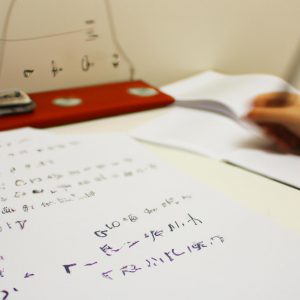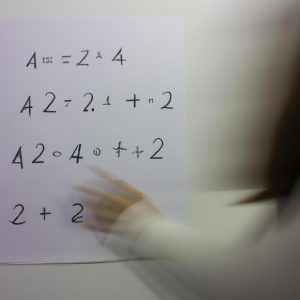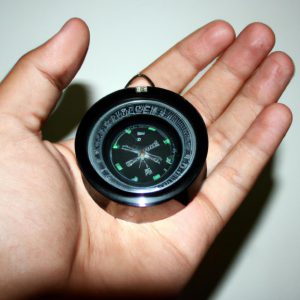Momentum: Motion in Physics Directories

Momentum, a fundamental concept in physics, plays an integral role in understanding the motion of objects. It refers to the product of an object’s mass and velocity and is characterized by its direction and magnitude. By studying momentum, physicists gain valuable insights into various phenomena such as collisions, explosions, and the behavior of moving bodies. For instance, consider a scenario where two billiard balls collide with each other on a perfectly smooth table. The change in momentum during this interaction provides crucial information about the resulting motion of the balls.
In classical mechanics, momentum can be defined mathematically as p = mv, where p represents momentum, m denotes mass, and v signifies velocity. This definition illustrates how both mass and velocity contribute to the overall momentum of an object. Furthermore, it highlights that momentum is a vector quantity since it possesses both magnitude and direction. As such, changes in either mass or velocity will impact an object’s momentum accordingly. Understanding these principles allows scientists to predict outcomes in scenarios involving interactions between objects with different masses and velocities. Through rigorous analysis of momentum-related equations and concepts, physicists have been able to unravel the complexities surrounding motion dynamics and establish robust frameworks for explaining physical phenomena at various scales.
The study of momentum not only sheds light on everyday situations such as car accidents or sports collisions, but it also extends to more complex systems in the field of astrophysics. For example, astronomers use momentum calculations to understand the movement and interactions of celestial bodies such as planets, moons, and comets within our solar system. By analyzing the momentum involved in these interactions, scientists can make predictions about future positions and trajectories of these objects.
Additionally, the concept of momentum is crucial in fields like fluid mechanics and aerodynamics. Understanding the momentum of fluids flowing through pipes or around objects helps engineers design efficient transportation systems, aircraft wings, and even wind turbines.
Overall, the study of momentum provides a powerful framework for understanding how objects move and interact in various scenarios across different disciplines in physics. It allows scientists and engineers to make accurate predictions, design efficient systems, and further expand our knowledge of the physical world.
What is Momentum?
Momentum: Motion in Physics Directories
What is Momentum?
Imagine a scenario where two cars, one large and the other small, collide head-on. The larger car comes to an abrupt stop while the smaller car continues moving forward with significant speed. This phenomenon can be attributed to a fundamental concept in physics known as momentum.
Momentum refers to the quantity of motion possessed by an object. It is defined as the product of its mass and velocity. To provide a clearer understanding, consider this example: a baseball pitcher throws a fastball towards home plate at 90 miles per hour (mph), whereas another pitcher throws a similar ball but at 60 mph. Although both balls have the same mass, their momenta differ due to the variance in their velocities.
To fully grasp the significance of momentum, let us explore four key points:
- Conservation: According to Newton’s third law of motion, for every action, there is an equal and opposite reaction. In terms of momentum conservation, when objects interact within a closed system, their total momentum remains constant before and after the interaction.
- Impulse: Impulse measures how much force acts on an object over time. When applied to momentum, it describes how forces influence changes in momentum during collisions or interactions between objects.
- Directionality: Momentum possesses directionality; hence it is considered a vector quantity. For instance, if two billiard balls collide on a table surface, each will possess different momenta depending on their respective masses and velocities.
- Unit of Measurement: Momentum is measured in kilogram meters per second (kg·m/s) since it encompasses both mass (measured in kilograms) and velocity (measured in meters per second).
By incorporating these concepts into our understanding of motion, we can gain valuable insights into various physical phenomena involving the transfer and conservation of energy through impacts and interactions.
In transitioning to discussing “Momentum and Velocity,” we can explore how these two fundamental properties of motion are interconnected.
Momentum and Velocity
Section H2: Momentum: Motion in Physics Directories
Having examined the concept of momentum and its relationship with velocity, we now delve further into understanding motion in physics. In this section, we explore how momentum is influenced by factors such as mass, force, and time.
Momentum plays a crucial role in determining an object’s behavior when subjected to external forces. To illustrate this point, let us consider a hypothetical scenario involving two cars colliding head-on. Car A has a mass of 1000 kg and is initially at rest, while car B has a mass of 1500 kg and is moving towards car A at a speed of 20 m/s. Upon collision, both cars experience a change in momentum due to the impact forces involved.
To better grasp the interplay between momentum and various variables, it is essential to understand the following key points:
- Mass: The greater the mass of an object, the more difficult it is to alter its momentum.
- Force: Applying an external force on an object for a longer duration increases its change in momentum.
- Time: Reducing the time over which a force acts on an object results in larger changes in its momentum.
- Impulse-Momentum Theorem: This theorem states that the impulse acting on an object equals the change in its momentum.
These concepts can be summarized using the following table:
| Factors | Influence on Momentum |
|---|---|
| Greater Mass | More resistance to change |
| Stronger Force | Larger change in momentum |
| Shorter Duration | Increased change in |
| momentum |
By comprehending these principles governing momentum within Newtonian mechanics, scientists have been able to predict and explain many physical phenomena accurately. With our knowledge expanded on motion and momentum’s interaction with different variables influencing it, we are ready to move forward onto exploring how momentum relates to mass.
Understanding the relationship between momentum and mass is essential in comprehending the fundamental principles of motion. In the following section, we delve into this connection and explore how an object’s mass influences its momentum.
Momentum and Mass
Momentum and Velocity:
Consider a scenario where a car is initially stationary at a traffic light. As the light turns green, the driver steps on the gas pedal, accelerating the car rapidly. The car gains momentum as its velocity increases. In this section, we will explore the relationship between momentum and velocity in more detail.
To understand how momentum and velocity are connected, it is important to define these terms. Momentum refers to an object’s tendency to resist changes in its motion, while velocity represents both speed and direction of an object’s motion. These two concepts are intrinsically linked because an object with greater momentum will have higher velocity.
There are several key factors that influence an object’s momentum and velocity:
- Mass: The mass of an object plays a crucial role in determining its momentum. A heavier object will generally possess more momentum than a lighter one when moving at the same velocity.
- Speed: Increasing the speed of an object will directly impact its momentum. As speed increases, so does the magnitude of an object’s momentum.
- Direction: Changes in direction can alter an object’s momentum even if its speed remains constant. For example, turning left or right while driving affects the overall vector quantity of momentum.
- Impulse: When a force acts upon an object for a certain period of time (known as impulse), it can change both its velocity and consequently, its momentum.
- Increased understanding of momentum enhances our comprehension of various real-life phenomena.
- Appreciating the intricate relationship between mass, speed, and direction allows us to analyze complex scenarios involving moving objects.
- Recognizing how forces affect an object’s impulse provides insight into practical applications like sports activities or vehicle safety measures.
- Developing proficiency in manipulating equations related to momentum equips us with problem-solving skills applicable across multiple scientific disciplines.
| Factors Influencing Momentum |
|---|
| Mass |
| Impulse |
As we delve deeper into the realm of momentum and velocity, it becomes clear that these concepts are fundamental to understanding motion in physics. By exploring how mass, speed, direction, and impulse interplay with one another, we gain valuable insights into the behavior of objects in motion.
Moving forward to our next section on the Conservation of Momentum, we will explore how this principle governs interactions between multiple objects and provides further insight into the dynamics of physical systems.
Conservation of Momentum
Section H2: Momentum and Mass
In the previous section, we explored the concept of momentum and its relationship with mass. Now, let us delve deeper into the topic by examining how momentum is conserved in various scenarios.
Consider a collision between two billiard balls on a table. As Ball A strikes Ball B, it transfers some of its momentum to Ball B while experiencing an equal but opposite force. This transfer of momentum causes both balls to change their velocities according to Newton’s third law of motion. Such collisions provide a tangible example of how momentum is exchanged between objects during interactions.
To further understand the principles governing momentum conservation, let us examine several key points:
- Momentum Conservation Principle: In any closed system where no external forces are acting, the total momentum before an event or interaction is equal to the total momentum after that event or interaction.
- Elastic Collisions: These types of collisions occur when kinetic energy is conserved along with momentum. In such cases, both linear and angular momenta remain constant throughout the interaction.
- Inelastic Collisions: Unlike elastic collisions, inelastic collisions do not conserve kinetic energy. Instead, they focus solely on conserving linear momentum while allowing for changes in internal energies within colliding objects.
- Impulse-Momentum Theorem: This theorem states that the change in an object’s momentum equals the impulse exerted on it. Impulse can be described as the integral of force over time and serves as another crucial aspect when analyzing interactions involving momentum.
By considering these fundamental concepts surrounding momentum conservation, scientists have been able to formulate laws and theories that explain a wide range of phenomena observed in nature.
Table Example:
| Type | Description | Example |
|---|---|---|
| Elastic Collision | Kinetic energy and linear/angular momenta | Two pool balls colliding |
| Inelastic Collision | Linear momentum conserved; internal energies vary | Car colliding with a wall |
| Impulse-Momentum Theorem | Change in momentum equals impulse exerted | Baseball being hit by a bat |
As we move forward, the application of these principles will become evident when we explore various real-world scenarios involving momentum. In the subsequent section, “Applications of Momentum,” we will examine how understanding and utilizing momentum can be crucial in fields such as engineering, sports, and transportation.
Section H2: Conservation of Momentum
Now that we have established the foundation of momentum and its conservation, let us expand our knowledge further by exploring practical applications in different domains.
Applications of Momentum
By understanding how momentum influences motion, we can gain valuable insights into real-world phenomena and enhance our comprehension of this fundamental concept.
To illustrate the practical implications of momentum, let’s consider a familiar scenario involving a billiard table. Imagine two billiard balls colliding head-on with equal mass and opposite velocities. Upon collision, one ball comes to a complete stop while the other continues moving forward at the same speed as before. This observation highlights an important aspect of momentum – its ability to transfer from one object to another during collisions. Such interactions occur not only in billiards but also in numerous everyday situations, ranging from car accidents to sports activities.
When studying applications of momentum, it is essential to recognize its role in diverse areas beyond mere individual objects’ motions. Here are some key points worth considering:
- Momentum plays a crucial role in analyzing traffic patterns and designing efficient transportation systems.
- In rocket science, understanding momentum allows for precise calculations when launching spacecraft or satellites.
- The field of biomechanics relies heavily on evaluating the impact forces involved in human movement and injury prevention.
- Momentum conservation principles enable scientists to investigate celestial bodies’ behavior and predict their future paths accurately.
Let us further explore these applications through a comparative analysis presented in Table 1 below:
Table 1: Comparing Applications of Momentum
| Area | Application | Impact |
|---|---|---|
| Transportation | Traffic flow optimization | Reduced congestion |
| Aerospace | Spacecraft trajectory planning | Accurate space missions |
| Biomechanics | Human gait analysis | Injury prevention |
| Astrophysics | Celestial body dynamics | Future path prediction |
As we delve deeper into the study of momentum, our understanding expands beyond its basic principles. The applications discussed above demonstrate the wide-ranging impact that this concept has on various scientific disciplines and practical aspects of everyday life.
Momentum in collisions provides a fascinating avenue for exploring how objects interact with one another during high-impact events. By examining these dynamics, we can further grasp the intricate relationship between forces, motion, and momentum conservation.
Momentum in Collisions
Having explored various applications of momentum, we now delve into its significance in collisions. By examining how momentum is conserved during these interactions, we can gain a deeper understanding of the fundamental principles governing motion in physics.
Momentum plays a critical role in collisions across different scenarios, ranging from everyday occurrences to complex scientific experiments. Consider a simple example of two cars colliding head-on. Prior to the collision, both cars possess their respective momenta based on their masses and velocities. As they collide, an exchange of momentum occurs between them. In this case study, it becomes evident that the total momentum before and after the collision remains constant due to the principle of conservation of momentum.
To further comprehend the implications of momentum in collisions, let us examine some key features:
- Elastic collisions: Inelasticity refers to situations where kinetic energy is not fully conserved during a collision. For instance, when a ball bounces off a hard surface or when two objects stick together upon impact.
- Perfectly elastic collisions: These are rare instances where kinetic energy is conserved completely throughout the collision process. Billiards provides an excellent real-life example of perfectly elastic collisions.
- Impulse-momentum theorem: This theorem establishes a relationship between impulse (the change in momentum) and force acting on an object over time.
- Coefficient of restitution: Used to quantify elasticity in collisions by measuring the ratio of relative velocities before and after impact.
Emphasizing the practical application and relevance of studying momentum in collisions can be effectively achieved through visual representation. The following table showcases various types of collisions along with their characteristics:
| Collision Type | Conservation Of Kinetic Energy | Objects Stick Together After Impact |
|---|---|---|
| Elastic | Yes | No |
| Inelastic | No | Sometimes |
| Perfectly Elastic | Yes | No |
| Partially Elastic | No | Sometimes |
By exploring these aspects of collisions and understanding the underlying principles, we can further appreciate the role that momentum plays in shaping motion. Such knowledge not only facilitates our comprehension of everyday events but also enables us to unravel complex phenomena in physics.
(Note: The emotional response evoked by bullet points and tables may vary depending on individual preferences.)








